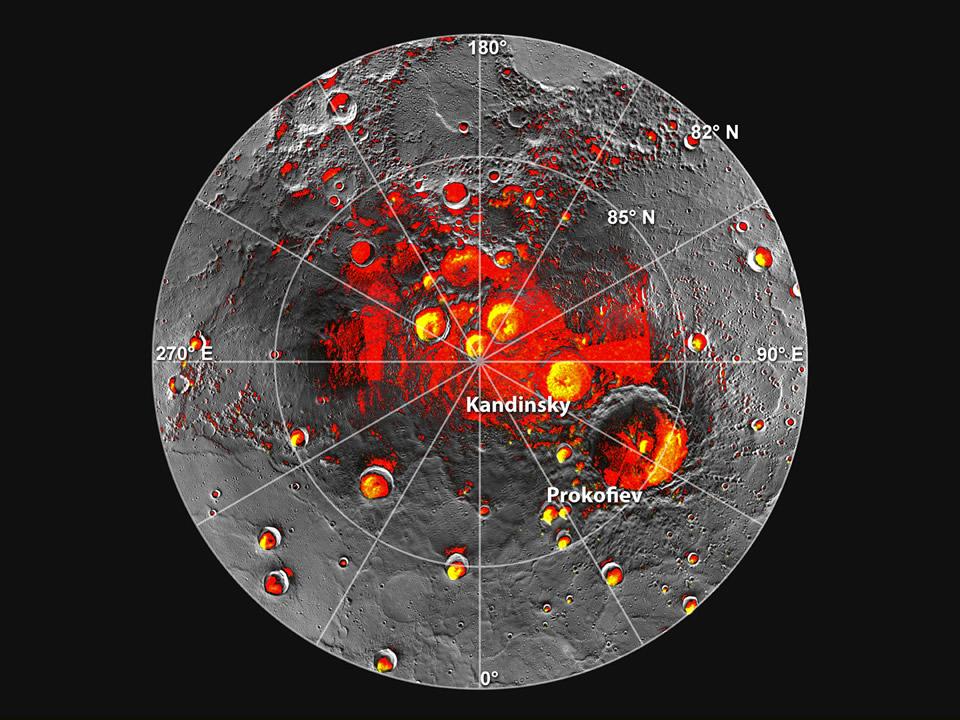Messenger finds new evidence for ice on Mercury

New data from NASA’s MESSENGER spacecraft suggest that there’s plenty of ice on Mercury’s polar regions. Given its proximity to the Sun, Mercury would seem to be an unlikely place to find ice. But the tilt of Mercury’s rotational axis is almost zero — less than one degree — so there are pockets at the planet’s poles that never see sunlight. Scientists suggested decades ago that water ice might be trapped in those shadowed areas at Mercury’s poles.
The new information comes from NASA’s MErcury Surface, Space ENvironment, GEochemistry, and Ranging (MESSENGER) spacecraft. Its onboard instruments have been studying Mercury in unprecedented detail since its historic arrival there in March 2011. Scientists are seeing clearly for the first time a chapter in the story of how the inner planets, including Earth, acquired their water and some of the chemical building blocks for life.
“The new data indicate the water ice in Mercury’s polar regions, if spread over an area the size of Washington, D.C., would be more than 2 miles thick,” said David Lawrence, a MESSENGER participating scientist at the Johns Hopkins University Applied Physics Laboratory (APL) in Laurel, Md., and lead author of one of three papers describing the findings in the online edition of Science Express.
 Shown in red are areas of Mercury’s north polar region that are in shadow in all images acquired by MESSENGER to date. Image coverage, and mapping of shadows, is incomplete near the pole. The polar deposits imaged by Earth-based radar are in yellow (from Image 2.1), and the background image is the mosaic of MESSENGER images from Image 2.2. This comparison indicates that all of the polar deposits imaged by Earth-based radar are located in areas of persistent shadow as documented by MESSENGER images. Updated from N. L. Chabot et al., Journal of Geophysical Research, 117, doi: 10.1029/2012JE004172 (2012).
Shown in red are areas of Mercury’s north polar region that are in shadow in all images acquired by MESSENGER to date. Image coverage, and mapping of shadows, is incomplete near the pole. The polar deposits imaged by Earth-based radar are in yellow (from Image 2.1), and the background image is the mosaic of MESSENGER images from Image 2.2. This comparison indicates that all of the polar deposits imaged by Earth-based radar are located in areas of persistent shadow as documented by MESSENGER images. Updated from N. L. Chabot et al., Journal of Geophysical Research, 117, doi: 10.1029/2012JE004172 (2012).Image Credit: NASA/Johns Hopkins University Applied Physics Laboratory/Carnegie Institution of Washington/National Astronomy and Ionosphere Center, Arecibo Observatory
The newest data from MESSENGER confirm that water ice is the major constituent of Mercury’s north polar deposits. In the coldest places, the ice is exposed on the surface. In slightly warmer spots, some kind of dark insulating material appears to cover the ice.
MESSENGER uses neutron spectroscopy to measure average hydrogen concentrations within Mercury’s radar-bright regions. Ice concentrations are derived, in turn, from the hydrogen measurements. This is possible because water, or H2O, is two parts hydrogen.
“The neutron data indicate that Mercury’s radar-bright polar deposits contain, on average, a hydrogen-rich layer more than tens of centimeters thick beneath a surficial layer 10 to 20 centimeters thick that is less rich in hydrogen,” says Lawrence. “The buried layer has a hydrogen content consistent with nearly pure water ice.”
Data from MESSENGER’s Mercury Laser Altimeter (MLA) — which has fired more than 10 million laser pulses at Mercury to make detailed maps of the planet’s topography — corroborate the ice hypothesis, writes Gregory Neumann of the NASA Goddard Flight Center. In a second paper, Neumann and his colleagues report that the first laser measurements of the shadowed north polar regions reveal irregular dark and bright deposits near Mercury’s north pole.
“Nobody had seen these dark regions on Mercury before, so they were mysterious at first,” Neumann says.
Neumann suggests that both the dark and bright materials were brought to Mercury by comets or asteroids, a finding corroborated in a third paper led by David Paige of the University of California, Los Angeles.
“The dark material is likely a mix of complex organic compounds delivered to Mercury by the impacts of comets and volatile-rich asteroids, the same objects that likely delivered water to the innermost planet,” Paige says.
This dark insulating material is a new wrinkle to the story, adds Sean Solomon of the Columbia University’s Lamont-Doherty Earth Observatory, principal investigator of the MESSENGER mission. “For more than 20 years the jury has been deliberating on whether the planet closest to the Sun hosts abundant water ice in its permanently shadowed polar regions. MESSENGER has now supplied a unanimous affirmative verdict.”
“But the new observations have also raised new questions,” adds Solomon. “Do the dark materials in the polar deposits consist mostly of organic compounds? What kind of chemical reactions has that material experienced? Are there any regions on or within Mercury that might have both liquid water and organic compounds? Only with the continued exploration of Mercury can we hope to make progress on these new questions.”
Source: NASA
Featured image credit: NASA/Johns Hopkins University Applied Physics Laboratory/Carnegie Institution of Washington/National Astronomy and Ionosphere Center, Arecibo Observatory

Commenting rules and guidelines
We value the thoughts and opinions of our readers and welcome healthy discussions on our website. In order to maintain a respectful and positive community, we ask that all commenters follow these rules.